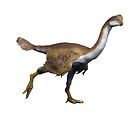|
Dromaeosauridae
Dromaeosauridae adalah sebuah keluarga dinosaurus theropoda berbulu. Mereka umumnya adalah karnivora berbulu ukuran kecil sampai menengah yang berkembang pada Zaman Kapur. Nama tersebut memiliki arti "kadal berlari", dari kata Yunani δρομαῖος (dromaîos), berarti "berlari dengan kencang" atau "gesit", dan σαῦρος (saûros), berarti "kadal". Secara informal, kelompok ini dikenal dengan nama raptor[2] (berdasarkan Velociraptor), yang dipopulerkan oleh film Jurassic Park; beberapa genera menggunakan istilah "raptor" secara langsung pada namanya, dan budaya populer sudah mulai menekankan wujud mirip burung mereka, beserta kemungkinan perilaku mirip burung mereka. Fosil dromaeosaurid ditemukan hampir di seluruh dunia, di Amerika Utara, Eropa, Afrika, Asia, Amerika Selatan dan Antarktika,[3] dengan beberapa fosil memberi kemungkinan bahwa mereka juga hidup di Australia.[4] Fosil tubuh terawal mereka diketahui dari kala Kapur Awal (145-140 juta tahun lalu) dan bertahan hidup hingga akhir periode Kapur, sebelum akhirnya musnah pada Peristiwa kepunahan Kapur–Paleogen 66 juta tahun lalu. Keberadaan genus ini pada kala Jura Tengah diusulkan, bedasarkan penemuan fosil gigi, meski absennya fosil tubuh.[5][6] Referensi
Pranala luarWikimedia Commons memiliki media mengenai Dromaeosauridae. Wikispecies mempunyai informasi mengenai Dromaeosauridae.
|
||||||||||||||||||||||||||||||
















